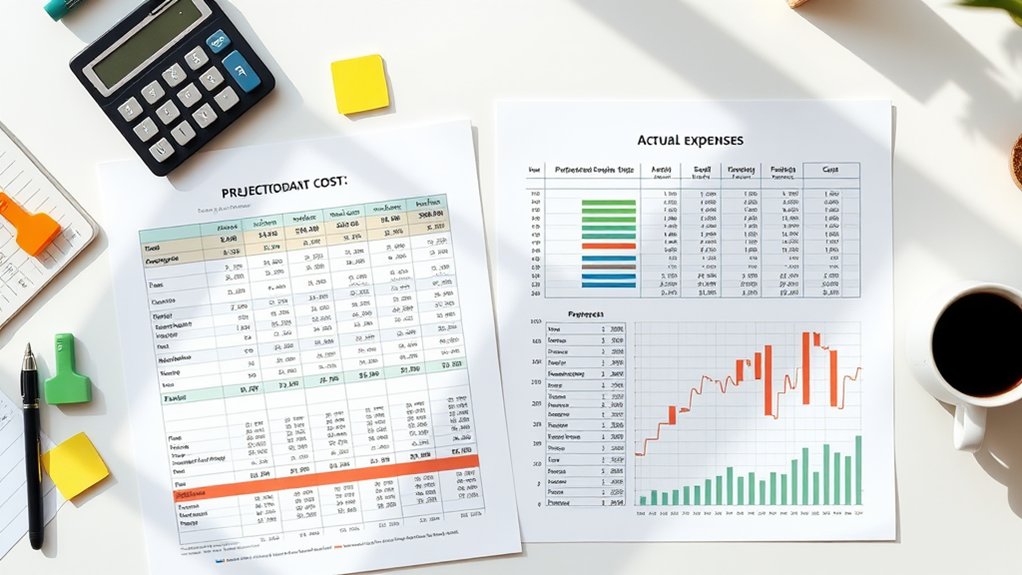I use bookkeeping data to systematically evaluate program effectiveness through key performance indicators and financial metrics. By tracking revenue streams, cost structures, and profit margins, I can calculate pivotal ratios like ROI, cost per acquisition, and program-specific contributions. I analyze budget variances, monitor expense patterns, and measure resource utilization rates against benchmarks to identify optimization opportunities. A deeper exploration of these analytical methods will enhance your program assessment capabilities.
Tracking Key Performance Indicators Through Financial Data
How can financial data reveal the true performance of your business programs? I track key performance indicators (KPIs) by analyzing revenue streams, cost structures, and profit margins for each program component. I measure program ROI by comparing resource investments against financial outcomes.
I examine metrics like cost per acquisition, customer lifetime value, and program-specific margin contributions. By monitoring these KPIs monthly, I identify underperforming segments that need optimization. I correlate financial patterns with operational data to pinpoint efficiency gaps. This enables me to make data-driven decisions about resource allocation and program scalability.
Cost-Benefit Analysis: Evaluating Program ROI
Conducting a thorough cost-benefit analysis provides a more granular view beyond basic KPI tracking. I’ll break down program costs against quantifiable benefits to calculate true ROI. I examine direct expenses like staffing and materials, plus indirect costs including overhead and opportunity costs.
I then monetize program benefits by analyzing revenue increases, cost savings, and productivity gains. By dividing total benefits by total costs, I determine the ROI ratio – anything above 1.0 indicates positive returns. I’ll also calculate the payback period to understand how quickly the program recoups its investment, helping me make data-driven decisions about resource allocation.
Budget Variance Analysis for Program Assessment

Budget variance analysis serves as a critical diagnostic tool for evaluating program performance against financial targets. I’ll help you leverage this analysis to assess your program’s financial health and identify areas requiring intervention.
- Compare actual spending against budgeted amounts to spot deviations quickly
- Calculate both favorable and unfavorable variances across cost categories
- Track spending patterns to identify seasonal fluctuations or unexpected trends
- Measure resource utilization rates against established benchmarks
- Analyze cost drivers to determine root causes of significant variances
When I detect variances exceeding predetermined thresholds, I investigate underlying factors and implement corrective measures. This systematic approach guarantees optimal resource allocation and strengthens program outcomes.
Financial Metrics for Measuring Program Success
Going beyond budget variances, financial metrics provide quantifiable standards to evaluate program performance and sustainability. I’ll show you how to leverage key ratios like cost per participant, revenue per service hour, and program margin percentages to measure effectiveness.
I calculate return on program investment (ROPI) by dividing net program benefits by total costs, while program efficiency ratios help me assess resource utilization. I also track trends in program-specific working capital and cash flow metrics to evaluate financial health.
Using Expense Patterns to Optimize Program Delivery

When analyzing expense patterns, I scrutinize detailed transaction data to identify optimization opportunities in program delivery. I map spending flows against program outcomes to reveal inefficiencies and potential cost savings. This data-driven approach helps me pinpoint areas where I can streamline operations without compromising quality.
- Track spending velocity to anticipate resource bottlenecks
- Monitor cost-per-participant ratios across different program segments
- Compare actual vs. budgeted expenses to identify variance patterns
- Analyze seasonal spending fluctuations to optimize resource allocation
- Evaluate vendor costs against delivered value metrics
Through systematic expense pattern analysis, I make strategic adjustments that maximize program ROI and strengthen operational efficiency.









